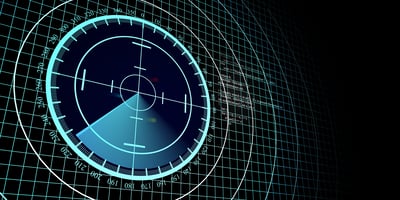Doppler radar systems use a phenomenon called the Doppler effect to produce data about a target. In...
What's The Difference Between Time Domain and Frequency Domain Analysis?
The time domain and frequency domain are two different ways to gather information about a signal. Each perspective can provide valuable insight into a signal’s behavior, strengthening product test and development.
This blog post will explain the key differences between the time and frequency domains and their relationship to one another.
Time Domain & Frequency Domain
The time domain represents how a signal changes over time. This perspective is already familiar to us since we use it every day. We perceive ourselves changing as the minutes, days, and years tick by – we live in the time domain.
The frequency domain shows the power level of a signal within individual frequency bands. Graphically, it plots the amplitude of each frequency component over a particular frequency range.
The video below shows an ideal RF signal that is free of distortions in both the time domain (amplitude vs. time) and the frequency domain (amplitude vs. frequency). Pay particular attention to the viewing direction of both domains in a three-dimensional space.
Beyond ideal, calculated behavior, what if a signal is composed of more than one frequency? In the video below, the time domain graph is a summation of amplitudes for all frequencies that are present in the signal. At certain points the frequency peaks may occur simultaneously, resulting in a higher combined amplitude in the composite signal. At other the points, the frequencies may cancel each other out.
In this case, the frequency domain can better reveal the magnitude of each frequency band.
Transformations are used to convert between the two domains mathematically. One common example is known as the Fourier transform (FT), which deconstructs the time-domain signal into separate sinusoidal waves. This process distinguishes the frequency and amplitude of each sinusoid that is part of the original waveform. In practical implementations, a fast Fourier transform (FFT) is used to convert to the frequency domain.
Measurement Examples
Time Domain – Envelope Power
The time domain is used for a myriad of measurements, including several related to a signal’s power. For example, envelope power represents a signal’s change in amplitude over time, which can occur due to modulation or distortion. When viewing a signal’s envelope power, as seen in the graph below, it can be a single shot capture or the average of more than one signal cycle. The highest amplitude reached is referred to as the peak envelope power (PEP).

Both envelope power and its maximum value can be used to quantify the peak power of a signal from a device under test (DUT). Understanding peak power can ensure a device performs as efficiently as possible and adheres to regulatory and safety specifications.
Frequency Domain – Phase Noise
Phase noise arises from a signal’s random phase fluctuations. In the frequency domain, this phenomenon results in sidebands that spread out on both sides of the carrier signal.
Radar systems typically require low phase noise levels, especially when dealing with radar returns that are both close to and weaker than the initial transmit frequency. These lower power, close-in signals can be completely obscured by the phase noise of the stronger transmit frequency.

Overall, the time domain and frequency domain are alternate ways to express waveforms. When applied properly to a specific design, both analysis techniques bolster the understanding of system performance.



